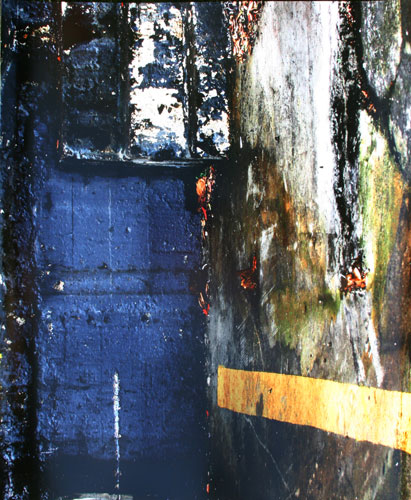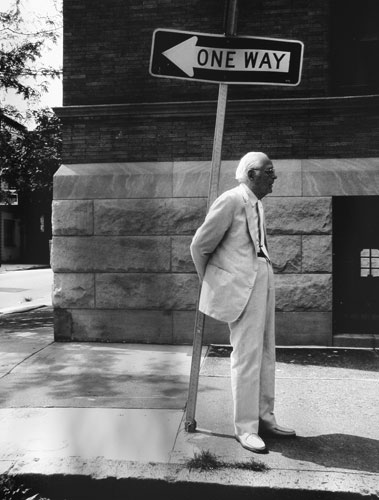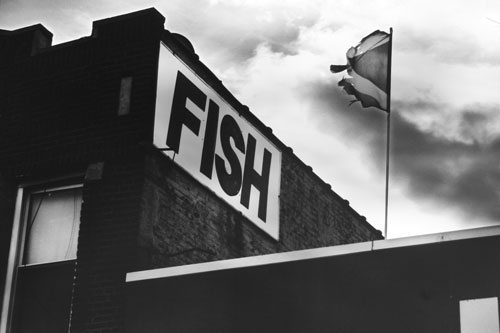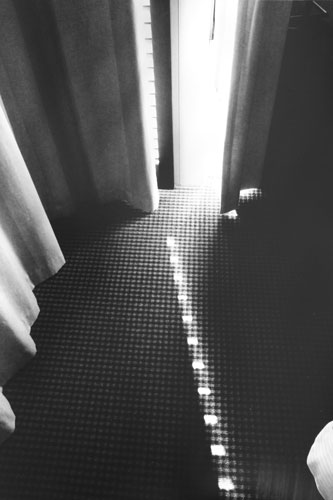 |
 |
 |
|
Contrary to what one might think, the sense and cultural significance of photography are not simply and directly related to its expansive contribution to the development of our civilization in the 20th century. This hypothesis might be also considered in relation to contemporary times, where it is confirmed by somewhat different facts from our cultural evolution at the beginning of the 21st century… The above remark seems necessary in order to realize a certain “debility” of the humanities in description, qualification and analysis in general, particularly of most recent cultural phenomena. Trying to define the problem briefly it might suffice to recall the obvious fact that the history of art (principally, but not only of painting) contains everything that has ever been painted and preserved as our cultural legacy, as the substance of our culture from recent decades or ages. In other words, all that exists in the history of painting as if automatically marks the range of art history – the history of painting is history of art! Other branches of art function in a similar manner. If we take the history of graphics, we expect it to be history of art in the sphere of graphic art… And if the category of kitsch exists and functions within art as such, if it is defined and analyzed, it is a kind of “opposition branded and domesticated”, something like a proof of the phenomenon of art, a proof by contradiction. So there – photography (in order not to call on other ghosts of contemporary art here) exists within our cultural legacy as its amorphous substance, because the history of photography is not history of art! Its amorphism comes mainly from the fact that as far as photography is concerned we cannot employ any uniform criterion of measuring the sense of producing individual photos. The discussion about the reasons behind the taking of concrete photographs should be closed before it is even started since this problem escapes all examination and even more so, all qualifications! It also results in the absence of a handbook of “the history of photographic art”… What we have are merely histories of photography! It is a well-known fact that “everyone can take photographs” – and everyone really can! Nowadays when we possess the technology necessary to make the process of picture-taking automatic everybody is able to produce an image using this special tool. In the context of my introductory remarks this hypothesis gains a truly Marxist kind of validation, based on the consideration of the relation between quantity and quality. That is why, though it is not the only reason, I would be inclined to defend the philosophical thought of Karl from Trier… True, it would be a cliché to say that not everything that belongs to the “pictorial substance” of photography is art and that actually very few people hold on to an opposing view. The relation of photography to art has been the subject of numerous analyses and often stormy discussions which in the end have not led us to any conclusions… The problem is unsolvable at the start – because we still do not know what art is! The paradox of conceptualists – that art is whatever has been named as such – did not solve the problem, just as it was not solved by Tatarkiewicz’s proposition, based on historical reflection and built of a series of alternatives. What does all this have in common with photographs by Wally Pfister? Nothing or almost nothing, or… it may be essential for them! |
I liked photographing people kind of on the sly with a long lens. I tried to capture stolen moments and find humor in them. I took pictures in natural light with interesting colors and shapes. But photography wasn't my main interest. Wally Pfister (www//imdb) |
|
Let us look at the facts… Here we have a Hollywood cinematographer with an Oscar! This is an objective fact! In the case of Pfister’s exhibition we have to do with photographs which were not produced in the professional mode – so are they… amateurish!? (Perhaps it would be better to call them non-professional in order to avoid the term “amateurish”, somewhat pejorative both in Polish and English). This is the initial catch here, the reason why we ought to look at these photographs more closely! This reason is much broader than one might think at first glance and it is constrained by the attractiveness of the answer to the question what kind of photographs this Academy Award winning cinematographer takes as a private person.
The distance between a professional photographer and an amateur seems at first so enormous that it is even difficult to grasp, especially if we consider its Hollywood dimension! It is equally difficult to ponder on the problem of “film photography and photographic photography…” If to the question whether anything like “film photography” actually exists we should answer in the affirmative, then it would mean that in the photographs taken by cimenatographers certain specific filmic features must be found. If so, we ought to somehow isolate and define them. But after a moment’s reflection we come to the conclusion that photography is always “photographic” and that it always retains its specificity among other branches of visual art. If there is any “contamination” in it, it is manifested only by the traces of presence of the given author and not by the presence of some elements of film, painting, graphics, etc. Thus it seems certain that we are unable to point out any differences between the photography of a cimenatographer and the photography of a photographer, especially if we take into account the visual qualities of the photographic image that result from the technological means of expression involved in the process of its registration, both when we use the good old “light and chemical method” and the modern method of “light and electronics” – in both cases the image is always produced “through & by the lens”. Photography remains an art of realistic origin, of a realistic image presented to the viewer as a plane activated according to the rules worked out by fine arts, by the elements that make up that image, the elements which present the contents. This is the heart of the matter: the contents, the result of photography’s realistic origin, the effect of mechanical copying of a visually accessible reality. A photograph always shows something, always presents a selected fragment of reality, selected by the author who noticed and photographed it. Therefore, whatever we see in the photograph, the problems which it presents become the evidence of the existence of these problems in reality. Putting this banal truth in somewhat other words: a photograph is a document of the world which surrounds its creators and it becomes their authorial interpretation of the problems of this world. Authorial interpretation is not limited merely to observing and selecting – the author also throws in his reworking of the formal means of expression, creating “the way of representation” that defines the legibility of the photogram. Therefore, photography documents reality and reflects the state of mind of the author. However, seen from a historical, geographical or cultural distance it shows rather reality than the author – let us remember this rule. This is because reality is always iconically accessible in the photographs, while the information about the author might cease to exist at all… However, photography thanks to its ability to copy, to reproduce the world, has its own spheres of visual attractions of the images produced. The intensity of these attractions is directly proportional to the degree in which the image remains faithful, or rather unfaithful to our conventional – because widespread and common – visual experience. “A different image of the world” is a slogan which defines this problem in a simple way. “A different image”, but “an image of the world” – we ought to bear this in mind also when looking at these photographs by Wally Pfister. In his case it is also worthwhile to reflect on the sphere from which “authorial difference” is generated, bearing in mind the above-mentioned cultural independence of the context in which these pictures are viewed, with regard to all that is hidden in the name “Hollywood” and that we are not always fully aware of. Focusing on Pfister’s photographs it is easy to see that they rather lack spectacular qualities. “Structures and textures” are ordinary and apparently have been long exploited by other artists, “the visual reflections on an object-as-a-piece-of-garbage” are equally obvious, and the subject matter is not as much photographically universal as it is almost always “interesting for later”, as a document; briefly speaking, the subject matter here is the human being… However, all of these photographs possess externally legible visual values that have always been exploited in photography, values that result from the simple act of “observing and photographying…”. These remarks define the sense of photography and justify the taking of photographs because they have to do with the now obsolete “FIAP aesthetics”. True, looking at these photographs we might consider them to be old-fashioned, as in the realm of “contemporary photography” (whatever that means) it is hard to find examples of such works. What is interesting here is that these are the works of an Academy Award winning cinematographer, which makes for a kind of their differentia specifica and paradoxically confirms their universality. Let me make a little digression here – it is worth noticing that the above-mentioned examples of the subject matter of the presented pictures will be equally unattractive – or attractive – in the next fifty years, like Weston’s “pepper” is attractive or unattractive… This statement is not a declaration of “the one and only correct aesthetics of a single photograph” which – perhaps with the exception of World Press Photo – has long been treated as passé, leaving the stage to photographic projects consisting of many photographs that cannot exist independently as images without the textual explanation of the author or a curator. A specific feature of the profession of a cinematographer, especially in a feature film, is the fact that he photographs a reality prepared and selected by the set decorator, producer, director, etc. A cimenatographer who wants to create an image must take into account all the conditions that will make the narrative leigible in order to ensure editing continuity, the domination of certain visual genre features, etc., and therefore he must do his job from the perspective of “how”, not of “what”! This is a partial key to the thematic range of pictures by Wally Pfister. They are a document of an involuntary reaction of the lens to the observed fragment of reality. The act of photographing does not obligate the author to anything! It does not depend on any conditions external to the act of taking a photograph. The set of photographs presented at this exhibition contains also other pictures. Different from those characterized above, although also easy to evaluate according to the rules of “aesthetics of a single photograph”. These pictures are characterized by a strong domination of various systems of chiaroscuro contrasts. Actually these contrasts even become their main subject, because the chiaroscuro dominates and moves aggressively to the forefront so that it pushes the so-called presented contents to the background. These photographs are an example of the conditions under which the author works as a professional - they refer to the above-mentioned “how”, i.e. to the realization of authorial expression by technical means. The author actually declares that he is fascinated by the technological possibilities in this field and makes it his credo in a statement published on an imdb page: “Film has an enormous amount of exposure latitude and dynamic range, which gives us infinite creative ability in creating images. I can underexpose it by 3 stops and overexpose it by 5 stops within the same frame and see the entire spectrum on the screen.” His admiration for such a broad contrast is the key to this set of pictures, the key which in this case is the evidence of the author’s fascination by those elements that generate the expression of a photographic image, a fascination filtered through the author’s professional attitude. Both the photographs recalled at the beginning of this text and those described above are a proof of their author’s visual sensitivity. One might want to call it an atavistic sensitivity because his photographs are in their own way journalistic, i.e. they are not burdened by intellectual speculation, they seem to have been taken as if involuntarily. Visual atavistic sensitivity, in fact, lies at the foundation of the work of all kinds of artists who produce images. Pfister’s Academy Award is also a piece of evidence in this respect. |
Stefan Czyżewski |
 |
 |
 |
 |
 |
| Wally Pfister, born in 1961 in Chicago. World famous American cinematographer, recipient of an Academy Award for the movie Inception and a three-time nominee for this award. He received 21 other awards and 16 nominations. Pfister collaborated for many years with Christopher Nolan. He was the author of photography in such films as The Dark Knight, Insomnia, The Dark Knight Rises, The Italian Job, The Prestige and many others - the full list includes over 40 titles. Member of the American Society of Cinematographers (ASC) and the British Society of Cinematographers (BSC). |
Copyright ©2012 Galeria FF ŁDK i Autorzy |